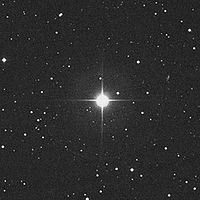Helvetios (star)
Helvetios (previously named 51 Pegasi) is a solar-type star located in the constellation Pegasus, 50.1 light-years from the Solar System. This star has the first discovered extrasolar planet, Dimidio (before 2015 known as 51 Pegasi b).
The exoplanet discovery announcement was made on October 6, 1995 by Michel Mayor and Didier Queloz in Nature. The method used for the discovery was the radial velocities method. They used the ELODIE spectrograph at the Haute-Provence Observatory.
Properties
The star Helvetios has an apparent magnitude of 5.49 so it is easily visible from Earth with binoculars and with the naked eye only under optimal conditions. Its number in the Hipparcos catalog is 113357, and in the Henry Draper Catalog it is 217014. It is a spectral-type star that appears as either G2.5IVa or G4-5VA, similar to the Sun, with a slightly older age. estimated 7.5 billion years older and 4-6% more massive. Its metallicity is also greater than that of the Sun.
In 1996 the astronomers Baliunas, Sokoloff, and Soon reported measurements on a sample of stars of the Calcium II H and K spectral lines from which they deduced a rotation period of 37 days for the star 51 Pegasi.
Planetary system
Dymidius, formerly 51 Pegasi b, was informally referred to as Bellerophon. After its discovery, its existence was confirmed through multiple observations that have revealed many of its characteristics. The detection method was that of radial velocities, which allows measuring the product of the planet's mass times the sine of the orbital inclination angle: m sin (i) = 0.468 +/- 0.007 (measured in Jovian masses). This method allows us to give a lower bound or minimum mass that the planet should have. The radial velocity variations have an amplitude of 59 m/s and show an orbital period of 4,239 ± 0.001 days. There has been much speculation about the possible existence of a lower mass planetary companion in more distant orbits to the point that 51 Pegasi is classified as one of the candidate systems to host a terrestrial planet in the so-called habitability strip, which in this system, with a star so similar to the Sun, it is also between 1 and 2 AU.
| Acompany (In order from the star) | Masa (MJ) | Orbital period (days) | Major semage (UA) | Eccentricity |
|---|---|---|---|---|
| Dimidio | Русский0.468 ± 0.007 | 4.23077 ± 0.00005 | 0.052 | 0 |
Contenido relacionado
Louis de Leon
Rigel
Absolute magnitude

